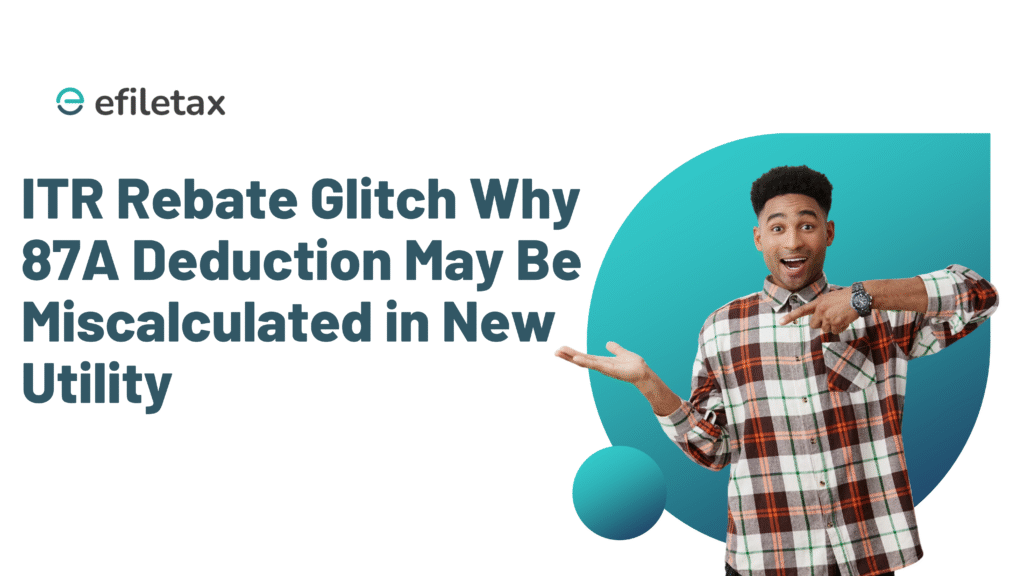
Section 87A Rebate Not Auto-Calculated in ITR Utility? Here’s What You Must Know
While filing Income Tax Return (ITR) for AY 2025–26, many taxpayers using the latest ITR utility have reported a key issue: the utility automatically calculates the rebate under Section 87A only on normal income, ignoring income taxed at special rates (like short-term capital gains under Section 111A or dividend income). This oversight can reduce your eligible rebate — unless you correct it manually.
Let’s break this down.
What is Section 87A Rebate?
Section 87A offers a tax rebate of up to ₹12,500 (or ₹25,000 in the new regime for income up to ₹7 lakh) for resident individuals with total income below the prescribed threshold.
- Old Regime: Rebate up to ₹12,500 if total income ≤ ₹5 lakh
- New Regime (115BAC): Rebate up to ₹25,000 if total income ≤ ₹7 lakh
Here’s the catch:
The total income includes both normal income and special rate income (like capital gains, winnings, or dividend income). So if your overall income is below the threshold, you’re entitled to the rebate — regardless of its composition.
ITR Utility Bug: Rebate Applied Only on Normal Income
Taxpayers have observed the following:
- At first click, rebate under Section 87A is calculated only against normal income
- Special rate income (e.g. STCG under 111A) is excluded from rebate computation
- The utility may wrongly show tax payable, even when you’re eligible for full rebate
This can lead to excess tax liability unless you notice the error and manually adjust.
How to Fix It: Manual Update Option in ITR Utility
✅ The utility does allow you to edit the rebate amount manually.
Here’s what you should do:
- Complete your income details (including salary, capital gains, other sources)
- Go to the Tax Payable or Tax Summary section
- Check the rebate auto-filled under Section 87A
- If it doesn’t consider your special rate income, click “Edit” or “Update”
- Enter the correct rebate (₹12,500 or ₹25,000 as applicable)
- Recalculate total tax liability
Important: Ensure your total income (including special rate income) is within the rebate threshold. Else, this will trigger validation errors.
Legal Angle: CBDT Clarification on 87A Scope
Although no fresh notification has been issued yet for this utility bug, past clarifications and court rulings make one thing clear:
- Rebate under Section 87A applies on total income
- Special rate income is not excluded for computing the ₹5 lakh or ₹7 lakh limit
- CBDT Circular No. 02/2023 affirms this for the new regime
So, if the total income is eligible, you get the full rebate — no matter the income source.
Expert Tip: Always Cross-Check Rebate Before Filing
Don’t blindly trust the utility’s first calculation. Here’s what you can do:
- Use Form 10E or Form 16 to compare total income
- Use the “Preview Return” option before submission
- If your capital gains or dividend income pushed total income just over ₹5 lakh, consider tax planning steps like 80C deductions
Summary
Many taxpayers face a Section 87A rebate issue in the ITR utility for AY 2025–26. The system only calculates rebate on normal income, ignoring special rate income. You must manually update the rebate field to avoid paying extra tax.
FAQs
Q1. Is Section 87A rebate available on capital gains?
Yes, if total income (including gains) is within the ₹5 lakh or ₹7 lakh threshold.
Q2. Why does the ITR utility show less rebate?
It calculates the rebate on normal income only. You must update it manually if eligible.
Q3. Can I claim 87A rebate under the new tax regime?
Yes. If your total income is ≤ ₹7 lakh, you can claim up to ₹25,000 under the new regime.
Q4. Will ITR be rejected if rebate is updated manually?
No, as long as your income qualifies, manual update is allowed and valid.
Final Word
The Income Tax Department’s ITR utility is a helpful tool, but not always error-free. The Section 87A bug can cost you thousands if you don’t catch it. Always double-check the rebate, especially if you have special rate income.
Need help verifying or filing your ITR correctly?